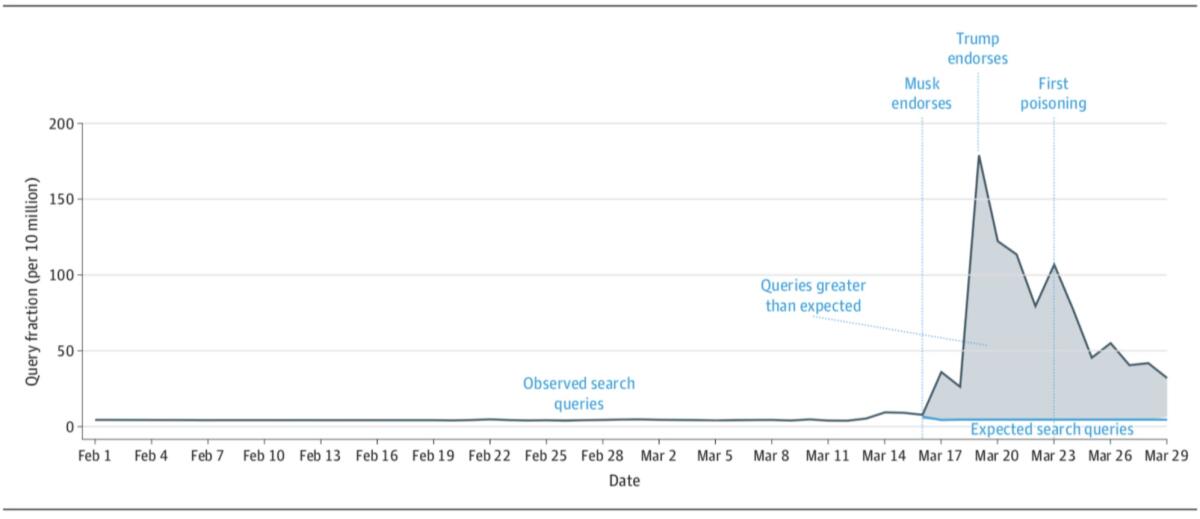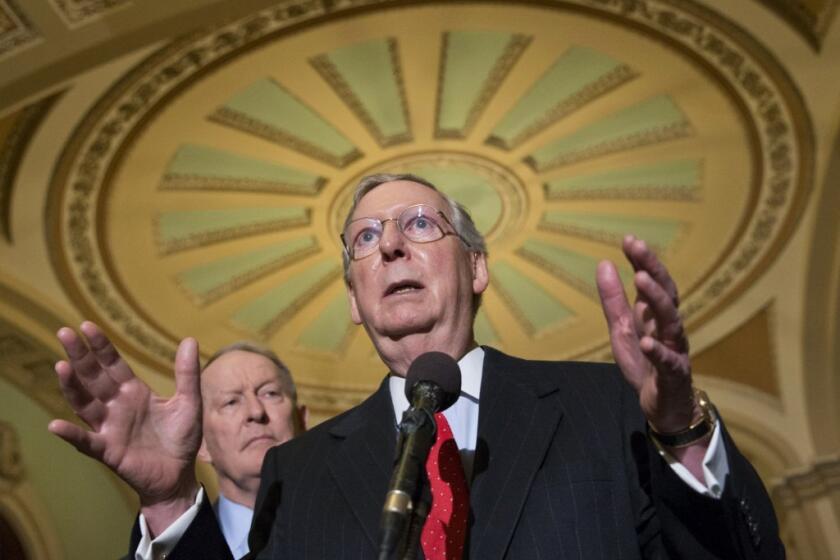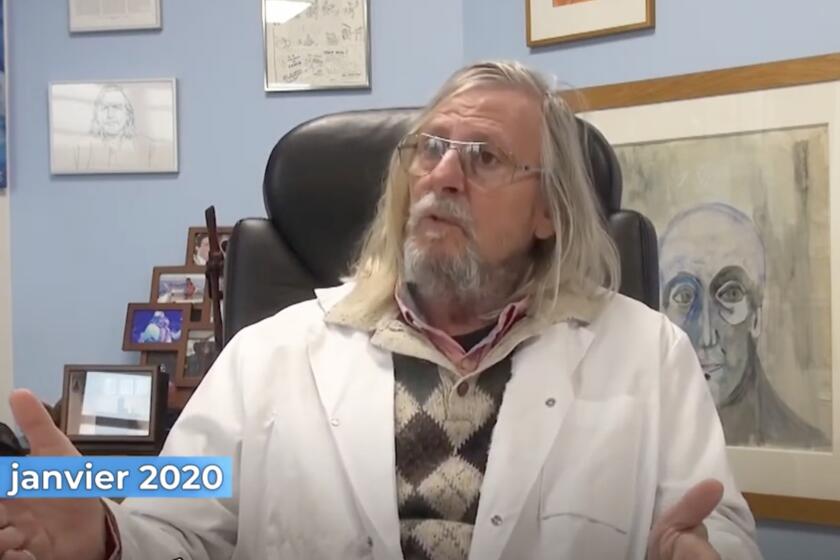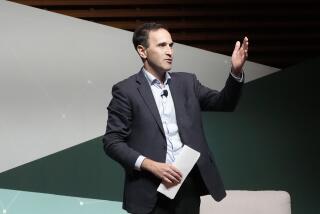Column: The COVID-19 crisis shows how dangerous misinformation becomes contagious

- Share via
In olden times, it was fairly easy to identify the sources of misinformation and cultural ignorance: They were either commercial entities that profited from misleading the public, such as tobacco companies, or conspiracy theorists and other inhabitants of the lunatic fringe.
“When it comes to misinformation, I normally tell people not to trust information unless it comes from a trusted source,” says Mark Dredze, an expert at Johns Hopkins University on how health-related misinformation and disinformation spread via social media. “Don’t take your health information from random websites and don’t take any medication without talking to your doctor.
“But how do you tell people to trust the federal government, but don’t pay attention to the president of the United States?”
Misinformation spreads rapidly, especially in a time of great fear. That’s always been true, from the burning of witches on up to hydroxychloroquine.
— Robert N. Proctor, Stanford University
That’s the question posed by a paper by Dredze and collaborators from Harvard, Oxford and UC San Diego published Wednesday by JAMA Internal Medicine.
The authors studied Google searches seeking information on how to buy chloroquine or hydroxychloroquine, the drugs touted by high-tech entrepreneur Elon Musk and President Trump as possible treatments for COVID-19, the disease caused by the new coronavirus.
They found that immediately after Musk and Trump began promoting the drugs as effective treatments for COVID-19, searches for purchasing information soared.
In just the two weeks after Musk first mentioned the drugs as possible treatments March 16, followed by a Trump tweet March 19, searches for purchase information rose by more than 200,000 over the average level before the COVID-19 crisis.
Rightwingers are using the pandemic to attack public workers, again
Even after news reports surfaced March 23 of a fatal chloroquine poisoning of a Phoenix man, searches remained elevated — more than 200% higher than the pre-COVID period for chloroquine, and 1,167% higher for the related drug hydroxychloroquine.
The lesson, according to the authors, is that “in times of public health crises, therapies not supported by adequate evidence should not be touted by public figures.”
Those words need to be reinforced consistently in the current crisis, when the loudest megaphone in the country is in the hands of Trump, a repeat violator of the principle. “We want to emphasize that speech really matters,” John W. Ayers, an epidemiologist at UC San Diego and coauthor of the paper, told me. “These collateral consequences of the COVID-19 pandemic can be very severe. The question is what can we do about it?”
“I was hoping that we had moved on — hydroxychloroquine was two or three weeks ago already, and it’s not relevant anymore,” Dredze says. “But if anything, it’s become clear that this is a pattern of behavior and not a one-time thing.”

Indeed, just days ago, Trump’s public discussion about injecting disinfectant to kill the coronavirus inside the body alarmed the entire healthcare establishment and even prompted the makers of Lysol and Clorox to issue consumer warnings against ingesting or using their products internally in any way.
Among the other research issues already under scrutiny by scientists, the novel coronavirus has become a fertile subject for experts in “agnotology,” defined as the study of the cultural production of misinformation.
“This is a great time for agnotology, living as we do in the golden age of ignorance,” says Robert N. Proctor, a professor of the history of science at Stanford and one of the pioneers in the field.
“Misinformation spreads rapidly, especially in a time of great fear,” Proctor says. “That’s always been true, from the burning of witches on up to hydroxychloroquine. When people are faced with a crisis, they become desperate.”
Proctor cut his agnotological teeth by studying Big Tobacco’s public relations campaign against the anti-smoking movement.
Hollywood’s iconic Musso & Frank Grill fights with its insurer over virus coverage.
“The tobacco industry knew that cigarettes caused cancer, and they knew with their iimmense resources they could get journalists to say there’s two sides to every story, that we need more research. Their genius was to fund immunology and genetics and genomics, all to give the impression that something besides cigarettes was causing cancer. It was really an obfuscation campaign to hide the truth.”
But that’s different from what’s coming from the White House. “Even to call Trump’s thing ‘misinformation’ is odd,” Proctor says, “because in what way is it information at all? It’s more like ‘mis-speculation.’ He‘s just kind of talking out loud. He’s not providing evidence.” Unlike the tobacco industry, he says, “I don’t think Trump is deliberately trying to fool anybody. He’s just ignorant.”
Still, ignorance issuing from such a high level produces entirely new challenges for anyone trying to keep the public from being misled. The threat is not only to the public’s understanding but also to the trust in the government itself.
“We see examples of the bully pulpit at the state level, of governors using the platform they have, because they’re governors, to be a central resource for informing people,” Dredze says.
“That’s really what the White House and the president do. Because the president commands national attention, he can bring important information to people. What we see here is that the bully pulpit is being used to convey conspiracy theories, medical misinformation, and information that’s flat-out dangerous and that sucks up time and attention from other important issues. This is really unprecedented.”
Meanwhile, the dearth of hard information about the epidemiology of the disease has created a vacuum that has been filled by pseudoscience wearing the mantle of expertise. Medical doctors have claimed to have found effective treatments for COVID-19 or come to unwarranted conclusions about its prevalence or lethality rates based on dubious evidence.
Often, these assertions aim to support an early reopening of businesses, even though epidemiological experts counsel against the premature lifting of stay-at-home policies. But the claims are spread widely via social media or on Fox News.
President Trump’s hype of a potential treatment for COVID-19 gives false hope to virus patients and causes real harm to others.
Fighting the tide of misinformation and ignorance may never have been harder. Ayers points out that Google has placed an information box on search pages for “coronavirus” that directs users to information about symptoms, testing, prevention and other issues, though it doesn’t do so on search results for chloroquine. Government health officials could aggressively contradict Trump’s musings about COVID-19 cures, but some have been loath to do so, given his mercurial nature.
By applying political pressure to federal science agencies, moreover, the Trump administration has undermined their position as trusted sources. Early in the crisis, Nancy Messonnier, director of the CDC’s National Center for Immunization and Respiratory Diseases, was sidelined as a public source after she spoke forthrightly about the social changes that the pandemic would force on Americans.
The Food and Drug Administration, which is tasked with overseeing the safety and efficacy of drugs, issued an exceedingly rare emergency use authorization for prescriptions of chloroquine and hydroxychloroquine, a step likely to be interpreted by laypersons as an endorsement, and one it would probably not have taken if Trump hadn’t turned the drugs into his personal hobbyhorses. To date, clinical trials across the world have failed to validate them as treatments for COVID-19.
Debunking misconceptions about COVID-19 or purported treatments is tricky. “In denying something,” Proctor says, “you bring attention to it, and some portion of the public will mishear that” as an endorsement.
The fundamental problem is that our inundation by information of all sorts coming through social media has fueled the old adage that “a lie can go halfway around the world before the truth can get its boots on” with steroids.
“One of the goals of Russian disinformation campaigns is to erode trust in the federal government,” Dredze says. “When we start talking about whether we can trust what the CDC is saying, or are they being suppressed, on the one hand that’s a really good question. On the other hand, that is the outcome that disinformation campaigns wanted in the first place. It’s very unhelpful when the underlying claim that you can’t trust your government turns out to be accurate. How do we combat that?”
More to Read
Inside the business of entertainment
The Wide Shot brings you news, analysis and insights on everything from streaming wars to production — and what it all means for the future.
You may occasionally receive promotional content from the Los Angeles Times.













